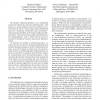Free Online Productivity Tools
i2Speak
i2Symbol
i2OCR
iTex2Img
iWeb2Print
iWeb2Shot
i2Type
iPdf2Split
iPdf2Merge
i2Bopomofo
i2Arabic
i2Style
i2Image
i2PDF
iLatex2Rtf
Sci2ools
ICDCS
2003
IEEE
2003
IEEE
Obstruction-Free Synchronization: Double-Ended Queues as an Example
We introduce obstruction-freedom, a new nonblocking property for shared data structure implementations. This property is strong enough to avoid the problems associated with locks, but it is weaker than previous nonblocking properties—specifically lock-freedom and wait-freedom— allowing greater flexibility in the design of efficient implementations. Obstruction-freedom admits substantially simpler implementations, and we believe that in practice it provides the benefits of wait-free and lock-free implementations. To illustrate the benefits of obstruction-freedom, we present two obstruction-free CAS-based implementations of double-ended queues (deques); the first is implemented on a linear array, the second on a circular array. To our knowledge, all previous nonblocking deque implementations are based on unrealistic assumptions about hardware support for synchronization, have restricted functionality, or have operations that interfere with operations at the opposite end of the...
Data Structure Implementations | Distributed And Parallel Computing | ICDCS 2003 | Nonblocking Deque Implementations | Obstruction-free Cas-based Implementations |
| Added | 04 Jul 2010 |
| Updated | 04 Jul 2010 |
| Type | Conference |
| Year | 2003 |
| Where | ICDCS |
| Authors | Maurice Herlihy, Victor Luchangco, Mark Moir |
Comments (0)

